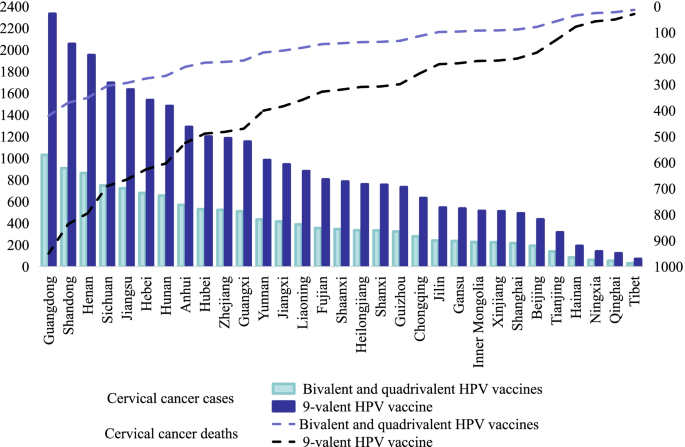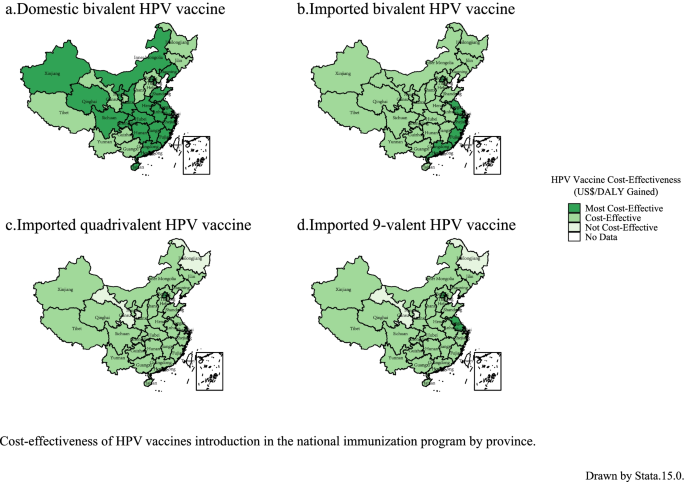Human papillomavirus vaccination at the national and provincial levels in China: a cost-effectiveness analysis using the PRIME model - BMC Public Health - BMC Public Health
Direct cost of HPV vaccines
From the perspective of vaccine valence types, the cost of the domestic bivalent HPV vaccine was the lowest, and the cost of the imported 9-valent HPV vaccine was the highest. The avoidable cost of treatment was highest for the imported 9-valent HPV vaccine, with the cost of treatment being the same for the domestic bivalent, imported bivalent and imported quadrivalent HPV vaccines. This is because the three kinds of vaccines (domestic and imported bivalent and imported quadrivalent) are effective against the same HPV subtypes, and they prevent the same number of cervical cancer cases. In terms of the net cost of prevention and treatment of cervical cancer, the net cost of the domestic bivalent HPV vaccine was the lowest, followed by the imported bivalent, imported quadrivalent and imported 9-valent HPV vaccines. The net cost at the national and provincial levels are shown in Table 2.
Effect of HPV vaccination on cervical cancer morbidity and mortality
At the national level, the lifetime incidence of cervical cancer for females of all ages, in the same birth cohort, who completed the full courses of the domestic bivalent, imported bivalent, imported quadrivalent, and imported 9-valent HPV vaccines at the target age was significantly lower than that of females in the cohort who did not receive HPV vaccination (Fig. 1). A total of 12,545 cervical cancer cases, and 5109 deaths were averted by the domestic bivalent, imported bivalent and imported quadrivalent HPV vaccines. For the 9-valent HPV vaccine, 28,140 cervical cancer cases and 11,459 deaths were averted.

The effect of vaccination on the incidence of cervical cancer by age in 2019
In 31 provinces, the incidence of cervical cancer decreased with age in the target population after HPV vaccination. The results showed that the number of cervical cancer cases, and deaths averted, life-years saved and DALYs prevented by the imported 9-valent HPV vaccine was higher than the other vaccines. Guangdong province, China's most populous province, had the most prevented cases, deaths, DALYs, and saved the most life-years, followed by Shandong and Henan provinces. Figure 2 shows the number of cervical cancer cases and deaths adverted by province. The number of cervical cancer cases and deaths averted, DALYs prevented, and life-years saved at a national and provincial level are shown in Additional file 6: Tables S9–S12.

Cervical cancer cases and deaths averted by HPV vaccination at the provincial level in 2019
The incremental cost per cervical cancer death averted after HPV vaccination in the target population was much higher than the incremental cost per cervical cancer prevented. The domestic bivalent HPV vaccine was the most cost-effective. This was followed by the imported bivalent, imported 9-valent and imported quadrivalent HPV vaccines. Nationally, the incremental cost of the bivalent HPV vaccine needed to avert cervical cancer cases was US$ 58,779, the incremental cost needed to avert cervical cancer deaths was US$ 144,329, the incremental cost to save one life-year was US$ 7879, and the incremental cost to prevent one DALY was US$ 7213. The incremental costs of cervical cancer cases and deaths averted, saving one life-year, and preventing one DALY with the imported quadrivalent HPV vaccine were US$ 148,034, US$ 363,490, US$ 19,843, and US$ 18,165, respectively (Table 3).
If the domestic bivalent vaccine with the best performance was used as an intervention for cervical cancer prevention, Heilongjiang province had the lowest incremental cost per case of cervical cancer averted, only requiring US$ 57,410, while Inner Mongolia had the highest incremental cost of US$ 61,977. The minimum cost per cervical cancer death averted in Henan province was US$ 140,032, and the maximum incremental cost per cervical cancer death averted in Inner Mongolia was US$ 152,182. Henan province had the lowest incremental cost per life-year saved, requiring US$ 7644; Inner Mongolia had the highest incremental cost at US$ 8308. When the imported quadrivalent vaccine was used as an intervention to prevent cervical cancer, Henan province had the lowest cost per case of cervical cancer morbidity and mortality, which was US$ 146,284 and US$ 359,193, respectively. Inner Mongolia had the highest incremental costs, with US$ 151,232 for morbidity prevention and US$ 371,343 for mortality prevention. Henan had the lowest incremental cost per life-year saved, at US $19,609, and Inner Mongolia had the highest, at US$ 20,272 (Additional file 7: Tables S13–S16).
Cost-effectiveness analysis of HPV vaccination
The four HPV vaccines were cost-effective at the national level compared to no HPV vaccination; Among the four vaccines, in 31 provinces, the domestic and imported bivalent HPV vaccines were cost-effective (< 3 times GDP per capita). The domestic bivalent vaccine was very cost-effective (<GDP per capita) in 22 regions including Liaoning, Beijing, Shanghai, Shandong, and Jiangsu. The provinces where the bivalent imported HPV vaccine was most cost-effective were mainly in the eastern coastal cities, including Beijing, Jiangsu, Shanghai, Zhejiang, Fujian, and Guangdong. The imported quadrivalent and imported 9-valent HPV vaccines were cost-effective in 29 provinces. The imported quadrivalent HPV vaccine was very cost-effective in Beijing and Shanghai, and the imported 9-valent HPV vaccine was very cost-effective in Beijing, Shanghai, and Jiangsu. There was no cost-effectiveness for the imported quadrivalent and imported 9-valent HPV vaccines in Heilongjiang and Gansu provinces (>3 times GDP per capita) (Fig. 3). The cost-effectiveness data are shown in Additional file 8: Table S17–S20.

Cost-effectiveness of HPV vaccination in 31 provinces in the target population in 2019
The bivalent and quadrivalent HPV vaccines target the same HPV subtypes, both can protect against HPV 16 and 18, therefore they have the same protective effect against cervical cancer. The 9-valent HPV vaccine had the highest per capita vaccination cost (US$ 574.71), followed by the imported quadrivalent (US$ 357.21), imported bivalent (US$ 262.38), and domestic bivalent HPV vaccines (US$ 153.2). At both the national and provincial levels, the imported bivalent HPV vaccine was approximately 1.7 times the price of the domestic bivalent HPV vaccine, and the imported quadrivalent HPV vaccine was approximately 2.3 times the price of the domestic bivalent vaccine. Therefore, the imported bivalent and imported quadrivalent HPV vaccines were less cost-effective than the domestic bivalent HPV vaccine. The price of the imported quadrivalent HPV vaccine was approximately 1.3 times that of the imported bivalent HPV vaccine, thus making the former less cost-effective. Compared with the bivalent and quadrivalent HPV vaccines, the 9-valent HPV vaccine provides more protection against cervical cancer. Although the price of the 9-valent HPV vaccine is higher, it provides higher protection against HPV. The 9-valent is more cost-effective than the quadrivalent HPV.
Sensitivity analysis
The model results were robust, and the discount rate was the main factor affecting the baseline results. When the discount rate was adjusted by + 2%, the imported bivalent, imported quadrivalent and imported 9-valent HPV vaccines went from being cost-effective to being cost-ineffective. In the sensitivity analysis of all valent HPV vaccines, the adjustment in discount rate caused the biggest change in the ICER value. After the discount rate was adjusted (±2%), the ICER value ranged from US$ 2311 to US$ 18,959 for the domestic bivalent HPV vaccine. With the imported bivalent HPV vaccine, the ICER value ranged from US$ 4523 to US$ 33,358. ICER values ranged from US$ 6444 to US$ 45,865 after vaccination with the quadrivalent HPV vaccine. ICER values ranged from US$ 7257 to US$ 35,869 after vaccination with the 9-valent HPV vaccine (Fig. 4). The data for the sensitivity analysis are shown in Additional file 9: Table S21.

Tornado diagram of the univariate sensitivity analyses (US$/DALY gained)

Comments
Post a Comment